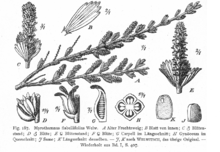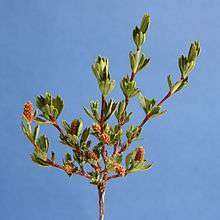Myrothamnus
Myrothamnus is a genus of flowering plants, consisting of two species[3] of small xerophytic shrubs, in the southern parts of tropical Africa and in Madagascar. Myrothamnus is recognized as the only genus in the family Myrothamnaceae.
| Myrothamnus | |
|---|---|
 | |
| M. flabellifolia[1] | |
| Scientific classification | |
| Kingdom: | Plantae |
| Clade: | Tracheophytes |
| Clade: | Angiosperms |
| Clade: | Eudicots |
| Order: | Gunnerales |
| Family: | Myrothamnaceae Nied.[2] |
| Genus: | Myrothamnus Welw. |
| Species | |
| |

Myrothamnaceae was included in order Hamamelidales in the Cronquist system.[4] Molecular systematic studies have suggested that Myrothamnus is not closely related to Hamamelidaceae nor any other family included in that order, but rather is closely related to Gunnera. In the APG II system (2003) the genus is assigned to family Gunneraceae or to the optionally recognized segregate family Myrothamnaceae.[5] In the APG III system (2009) and APG IV system (2016) the narrower circumscription is preferred, and these two families are considered distinct[2][6]
Species
- Myrothamnus flabellifolius Welw. - Angola, Southern Africa, Zimbabwe
- Myrothamnus moschata (Baill.) Baill. - Madagascar
References
- Myrothamnus flabellifolia, illustration from Vegetation der Erde (1915) v. 9 Band III, Heft 1. Fig. 187. by Adolf Engler (1844-1930)
- THE ANGIOSPERM PHYLOGENY GROUP (October 29, 2009). "An update of the Angiosperm Phylogeny Group classification for the orders and families of flowering plants: APG III". Botanical Journal of the Linnean Society. 161 (2): 105–121. doi:10.1111/j.1095-8339.2009.00996.x.
- Christenhusz, M. J. M. & Byng, J. W. (2016). "The number of known plants species in the world and its annual increase". Phytotaxa. 261 (3): 201–217. doi:10.11646/phytotaxa.261.3.1.
- Cronquist, Arthur (1981). An integrated system of classification of flowering plants. Columbia University Press. ISBN 9780231038805.
- THE ANGIOSPERM PHYLOGENY GROUP (April 2003). "An update of the Angiosperm Phylogeny Group classification for the orders and families of flowering plants: APG II". Botanical Journal of the Linnean Society. 141 (4): 399–436. doi:10.1046/j.1095-8339.2003.t01-1-00158.x.
- Angiosperm Phylogeny Group (2016). "An update of the Angiosperm Phylogeny Group classification for the orders and families of flowering plants: APG IV". Botanical Journal of the Linnean Society. 181 (1): 1–20. doi:10.1111/boj.12385. ISSN 0024-4074.CS1 maint: uses authors parameter (link)
External links
| Wikimedia Commons has media related to Myrothamnus. |
- NCBI Taxonomy Browser
- Myrothamnaceae in Stevens, P. F. (2001 onwards). Angiosperm Phylogeny Website. Version 7, May 2006.
- Myrothamnaceae in L. Watson and M.J. Dallwitz (1992 onwards). The families of flowering plants: descriptions, illustrations, identification, information retrieval. Version: 21 May 2006. http://delta-intkey.com
- links at CSDL